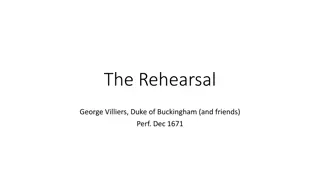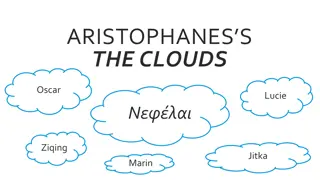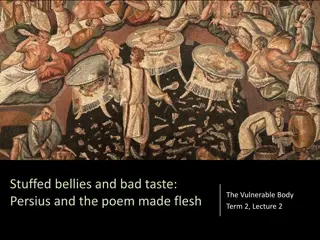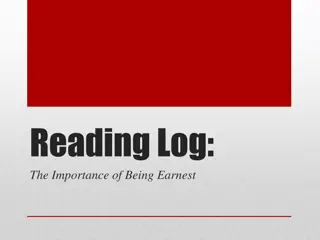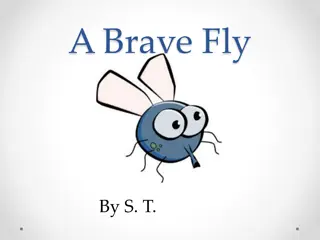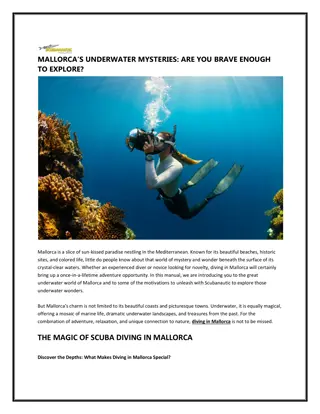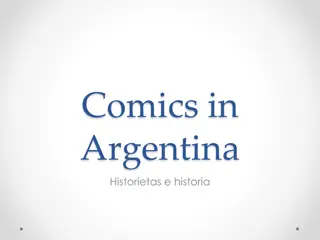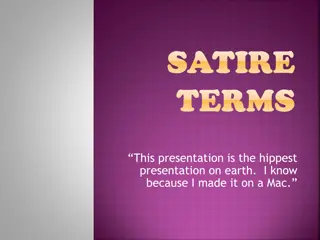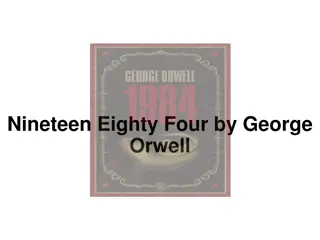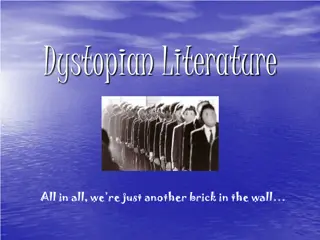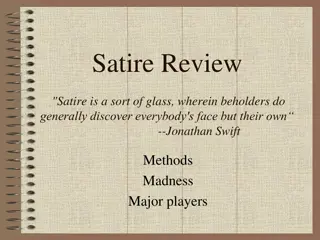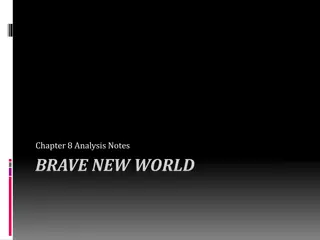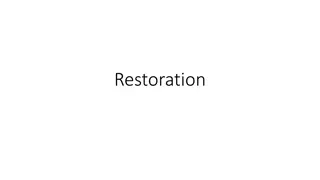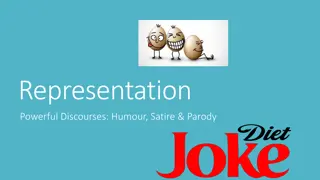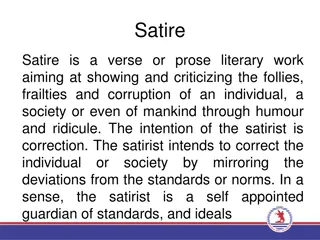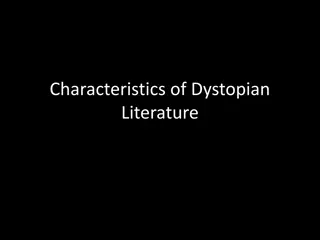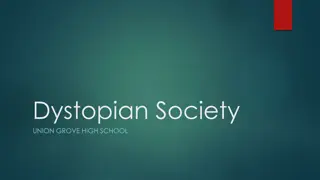Exploring "Brave New World": An Introduction to Dystopian Satire
This guide provides an overview of Aldous Huxley's "Brave New World," discussing its themes of propaganda, censorship, conformity, genetic engineering, and social conditioning. Delve into the novel's depiction of a controlled society, the use of technology, consumerism, and the satire employed to critique societal norms. Encounter thought-provoking topics such as the balance between happiness and truth, individuality versus community, and the perils of state power, all within the context of a dystopian world.
Download Presentation

Please find below an Image/Link to download the presentation.
The content on the website is provided AS IS for your information and personal use only. It may not be sold, licensed, or shared on other websites without obtaining consent from the author. Download presentation by click this link. If you encounter any issues during the download, it is possible that the publisher has removed the file from their server.
E N D
Presentation Transcript
Brave New World Summer Reading for Pre-AP English II an introduction to the novel, satire, and dystopian literature 1
Brave New World Author: Aldous Huxley, 1894 - 1963 Genre(s): Dystopian fiction, satire Relevance: deals with propaganda, censorship, conformity, genetic engineering, social conditioning, and entertainment Origin of Title: "O wonder! How many goodly creatures are there here! How beautious mankind is! O brave new world, That has such people in't! (from Miranda's speech in Shakespeare's The Tempest, Act V, Scene I -be prepared to discuss significance/meaning 2
Intro to Novel Huxley s novel expresses concerns specifically regarding elements of communism and capitalism and centers around a world of control and manipulation. A.F. stands for After Ford In this society, they base everything on the ideas of assembly line mass production and consumerism, so Ford has become like a god to them. There is a five-tiered caste system consisting of Alphas, Betas, Gammas, Deltas, and Epsilons. Every member of society has access to a drug called soma so that they never have to experience pain or unhappiness. Members of society are conditioning for their world and caste beginning before birth and continuing after birth. Reproduction is not part of a family structure (which is seen as outdated and disgusting in this dystopia), but embryos are conditioned for their caste, and babies are born in a factory setting. 3
Issues/Topics Each of these topics could be developed into a theme statement after reading the novel. Watch for these and annotate examples as you read: The use of technology to control society Consumerism, industrialization and consumption The relationship between pain and happiness, or between truth and happiness (reality versus hallucinations or reality versus appearances) The danger of an all-powerful state Individuality versus community Freedom vs. happiness Immediate gratification or escape from problems 4
Satire: A piece of literature designed to ridicule the subject of the work. While satire can be funny, its aim is not to amuse, but to arouse contempt. Ridicule, irony, exaggeration, and several other techniques are almost always present. 5
Satire Defined Satire is one of the oldest, most durable forms of literature, generally possessing the following traits: Aims to spark rebuilding and reformation in society Usually cherishes a sound society, good traditions, and wise, viable institutions Values the general welfare and the public good Targets an audience who is reasonably intelligent, educated, and rational 6 https://staff.rockwood.k12.mo.us/maiercrystal/AP%20Lit/Documents/Brave%20New%20World/Understanding%20Satire.pdf
Satire vs. Sarcasm Satire Sarcasm blend of criticism and humor, mockery, ridicule, etc., for the purpose of improvement Cutting remarks usually consisting of a series of insults 7 https://staff.rockwood.k12.mo.us/maiercrystal/AP%20Lit/Documents/Brave%20New%20World/Understanding%20Satire.pdf
Questions to Consider 1. What institutions, practices, and/or groups are being satirized? A group or organization Individuals A sort or type of person A social class A prevailing philosophy Social manners Modern progress Mankind or human nature 8 https://staff.rockwood.k12.mo.us/maiercrystal/AP%20Lit/Documents/Brave%20New%20World/Understanding%20Satire.pdf
Questions to Consider 2. What is the tone of the satire? Horatian this form aims to correct through broad laughter cheerful, urbane, tongue-in-cheek, optimistic, warm, witty, gentle, chiding Juvenalian this form aims to reforms through mocking ridicule cutting, bitter, angry, contemptuous, grim, sardonic, harsh, indignant 9 https://staff.rockwood.k12.mo.us/maiercrystal/AP%20Lit/Documents/Brave%20New%20World/Understanding%20Satire.pdf
Utopia vs. Dystopia Utopia A place, state, or condition that is ideally perfect in respect of politics, laws, customs, and conditions Dystopia A futuristic, imagined universe in which oppressive societal control and the illusion of a perfect society are maintained through corporate, bureaucratic, technological, moral, totalitarian control. Dystopias, through an exaggerated worst-case scenario, make a criticism about a current trend, societal norm, or political system. http://www.readwritethink.org/files/resources/lesson_images/lesson926/DefinitionCharacteristics.pdf ReadWriteThink materials may be reproduced for educational purposes. 10
Characteristics of a Dystopian Society Propaganda is used to control the citizens of society. Information, independent thought, and freedom are restricted. A figurehead or concept is worshipped by the citizens of the society. Citizens are perceived to be under constant surveillance. Citizens have a fear of the outside world. Citizens live in a dehumanized state. The natural world is banished and distrusted. Citizens conform to uniform expectations. Individuality and dissent are bad. The society is an illusion of a perfect utopian world. http://www.readwritethink.org/files/resources/lesson_images/lesson926/DefinitionCharacteristics.pdf ReadWriteThink materials may be reproduced for educational purposes. 11
Types of Dystopian Controls Corporate Control: One or more large corporations control society through products, advertising, and/or the media. Examples include Minority Report and Running Man. Bureaucratic Control: Society is controlled by technology through computers, robots, and/or scientific means. Examples include The Matrix, The Terminator, and I, Robot. http://www.readwritethink.org/files/resources/lesson_images/lesson926/DefinitionCharacteristics.pdf ReadWriteThink materials may be reproduced for educational purposes. 12
Types of Dystopian Controls Technological control Society is controlled by technology through computers, robots, and/or scientific means. Examples include The Matrix, The Terminator, and I, Robot. Philosophical/religious control Society is controlled by philosophical or religious ideology often enforced through a dictatorship or theocratic government. http://www.readwritethink.org/files/resources/lesson_images/lesson926/DefinitionCharacteristics.pdf ReadWriteThink materials may be reproduced for educational purposes. 13
The Dystopian Protagonist often feels trapped and is struggling to escape questions the existing social and political systems believes or feels that something is terribly wrong with the society in which he or she lives helps the audience recognize the negative aspects of the dystopian world through his or her perspective 14
Essential Questions to connect the literature to today s culture: Is it better to be free than to be happy? Is freedom compatible with happiness? Is the collective more important than the individual? Can children be taught effectively to think in only one certain way? Can young people be taught so well that they never question their teachings later? Is stability more important than freedom? Can alterations made by advanced science to mankind be made permanent at the DNA-level? Can mankind be conditioned by science? Should the individual be limited/controlled for the greater good? If so, how much? 15



